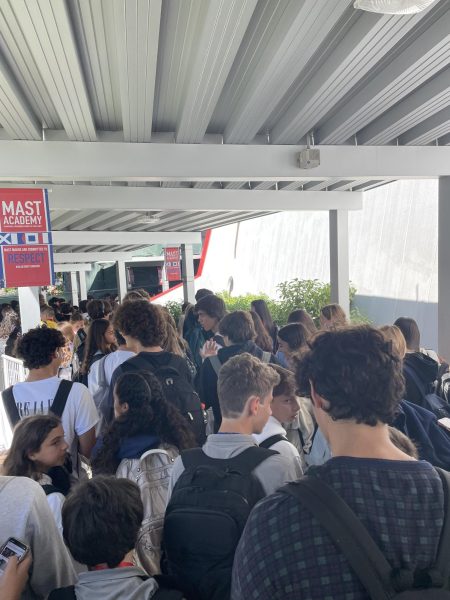Every day at 10:46 a.m., students and staff at MAST Academy prepare for the burst of students coming both up and down the ramp connecting the school’s two buildings. Walking through the ramp during the transition between Period 2 to Period 4 or Period 3 to Period 5 means potentially being cramped, shoved, or tripped. Walking from class to class, something students are required to do, has become a potential hazard.
“I’m afraid of getting injured, so during this change of classes I stay out of the halls,” MAST physics teacher Dr. Hood said.
On top of being a potential safety hazard for students and teachers, the traffic that occurs during this transition creates a tardiness issue. The immense number of students on the ramp at once with only one entrance and one exit generates an overload of traffic. This traffic delays students, making it difficult to get to class on time if they are traveling from one building to the other.
MAST has not set any protocols or policies for students who are late due to this traffic, so it has been left for teachers to decide how to mark these students. MAST history teacher Brian Mcfarland explained he is normally fairly strict, marking students late as soon as the bell rings. However, due to complaints from students and what he sees of the ramp traffic, he is more lenient with students in his Period 4 and Period 5 classes and will mark them on time even if they arrive a little bit after the late bell rings.
“I am late for nearly every class going from 3rd to 5th period. It’s become a frustrating part of my routine,” MAST Academy senior Mauro Iurman said.

To better understand the tardiness issue that ramp traffic creates, The Beacon conducted a research experiment. Two students, one coming from the third floor of Building 5 going to the main building and the other from the main building going to the fourth floor of Building 5, left their classes right as the bell rang and calculated how much time it took for them to reach their class. The student coming from the third floor reached class on time with less than a minute until the bell rang. The student coming from the main building reached class approximately fifteen seconds before the bell rang.
The research demonstrates that while it is possible for students to reach class on time even with the traffic, it is only possible in near-perfect circumstances. A student must be out the door as soon as the bell rings and walk directly to class without stopping. This is typically not the case at MAST, as teachers are instructed to teach “bell to bell.” Students are supposed to pack up when the bell rings and no earlier.
Cause for the delay
The reason for the intense traffic during this transition seems to come from the construction of the Beacon lighthouse located at the entrance of the main building. This has blocked off one of the entryways to the main building, generating bottleneck traffic at the only other exit and entry. Additionally, all middle school students have lunch at the beginning of Period 4 and 5. Having them all enter the main building at the same time, with high school students trying to get in and out of the main building as well, only adds to the traffic.
“The bulk of [the construction] is in the rear view at this point, so this construction should be completed sooner rather than later,” MAST Vice Principal Giuseppe Semeraro said.
With the construction expected to come to an end soon, students and faculty at MAST should expect the traffic to be somewhat relieved in the upcoming months.